
Andy Lloyd's Dark Star Blog

Blog 38 (May 2016)
Nibiru and the Younger Dryas Boundary
I'm really enjoying Graham Hancock's new book "Magicians of the Gods"
(1), which is a rather belated sequel to his bestseller "Fingerprints of
the Gods" (2) - a book which steered my interest in the direction of
ancient cataclysms and their impact on Ice Age peoples and their
(possible) lost civilisations. The incredibly ancient site of
Göbekli Tepe in Turkey strongly indicates how far humanity had already
come as the Ice Age drew to a close, and other (often submerged)
archaeological sites offer similar tantalizing evidence of Ice Age
civilisations.
Those interested in archaeo-astronomy have been
quick to discern sky markers to constellations at Göbekli Tepe, perhaps
indicating that these ancient post-Ice Age folk were trying to tell us
something about what had taken place. The famous Pillar 43, for
example, seems to clearly show the constellation of Scorpius, with an
enigmatic central disk lying within the non-zodiacal constellation of
Cygnus (represented here by a vulture) (3,4). The central belt of
Orion also seems to feature heavily in the monument's ancient alignments
(3).
Pillar 43 at Göbekli Tepe
As Hancock points out, the academic
geological community has a gradualist approach towards the formation of
geophysical surface features, and does not take kindly to catastrophist
arguments pertaining to eras featuring modern humans. Clearly, the
vast majority of the 100,000 years or so when modern humans have lived,
toiled and built communities together took place during Ice Age
conditions. Much of the North American and European continents
were covered in ice caps, and conditions elsewhere were arid.
As
so much of the Earth's water was part of these enormous ice caps and
glaciers, the world's sea levels were significantly lower than they are
now. As humans tend to favour coastal communities, then any
vestiges of Ice Age villages, towns - even cities - would inevitably have
been entirely inundated by rising sea levels as the Ice Age (which had
lasted 4 million years) drew to a close. Evidence of Ice Age epoch
stone structures or monuments would have been consumed by the seas,
lying below hundreds of feet of water. One of
the central questions about this alteration in our climate, and the
effect it had on modern humans, is how rapid the change was.
Centuries, decades, years, months, days? Opinions differ as to
whether this was a gradual change, seeing the melting of ice caps over
time, and the inevitable migration of peoples as sea levels gradually
rose; or whether there were geophysical events triggering sudden
disastrous Earth-changes. Hancock argues for the later, leaning
towards some kind of underlying reality behind the ancient Atlantis
myths whereby a catastrophic melting of the northern ice caps inundated
coastal Ice Age civilisations practically overnight. Of course,
this is a rather romantic construct, born of ancient myth offered by the
great Greek philosopher Plato. But whether or not a whole
continent somewhere west of Europe actually disappeared under the seas
or not, there could well be some truth to the concept that Ice Age
civilisation, in whatever form it took, was destroyed in a cataclysm
which brought the Ice Age to a sudden and devastating end. The arguments for a catastrophic end to the Ice Age
(which itself was not a static phase lasting 4 million years, but rather
a steep, jagged roller-coaster of glacial and warmer inter-glacial periods)
concentrate on events argued to have taken place at the so-called
Younger-Dryas boundary. This marked a transition into a
particularly cold period across the northern hemisphere known as the
Younger-Dryas, which lasted from about 12,900 to around 11,700 years
ago. In the thousands of years running up to 12,900 B.P. (Before
Present), there had been a gradual warming of the world. At this
point, the northern hemisphere was suddenly plunged back into the
freezer.
Fragile Earth at the end of the last Ice Age Many have advocated a sudden, catastrophic event causing
this unexpected change in the global climate, at the forefront of which
is the Younger Dryas impact hypothesis involving the alleged airburst or
impact of cometary fragments above or into the extensive northern ice
cap (5). In his new book, Hancock logs the growing body of
scientific papers presented in support of an extinction-level cosmic
event ~12,900 B.P. (1), beginning with the 2007 paper by Firestone,
Kennett and West which first proposed the 'Clovis Comet' (6). He
also argued that there has been a significant rearguard action by the gradualists to contain or
debunk this hypothesis (7), and that this increasingly tired fight-back
continues to lose ground. These arguments centre around the
reproducibility of evidence, particularly of the magnetic spheres
sampled from various, and their ages. There's a pecking order within the arena of
intellectual debate. That hierarchy is very structured and
formalised within academia. Free-thinkers like Graham Hancock
generate great book sales through their easy-to-access writing styles
and exciting out-of-left-field ideas, but barely register within the
ivory tower circles that count (at least in terms of the educational
dissemination of knowledge). So, academics interested in such
matters as these might highlight their work to researchers like Hancock,
knowing that it fans the flame of the broader publicity they might seek,
but don't necessarily seek his approval. This theme is also a
trademark of the book. That self-same pecking order exists outside
academia - in the little-leagues, as it were. So, what I might
suggest here won't necessarily meet the approval of Mr Hancock (indeed,
it most certainly will not), but I think it's pertinent nonetheless.
That's because my ideas about cosmic catastrophism within the solar
system centre around (but are not necessarily exclusive to) Planet X,
Nibiru... call it what you will. When I read the date 12,900 B.P.,
my eyes likely widened a little. That
dating (actually 13,000 B.P. here) was mooted by Zecharia Sitchin back in
1976, for the Deluge which catastrophically ended the last Ice Age (8).
At the time of writing, Sitchin was particularly intrigued by the
possibility that the Flood had been caused by a catastrophic slippage of
part, or all, of the Antarctic ice sheet. The resultant tsunami
would have swept around the world, causing devastating flooding, raising
sea-levels instantly, and burying fauna. This particular idea had
been proposed by Dr John T. Hollin (9), as outlined in this New York Times
article (which also mentions J Bretz, much discussed by Graham Hancock):
"In 1972, John T. Hollin, a British graduate
student at Princeton University, proposed that an Antarctic slippage
might be sudden enough to cause sudden global flooding. He cited the
"London brickearth," a deep clay deposit used to make bricks for
London's old buildings. During the last century the remains of
"elephants," generally assumed to have been victims of the Biblical
flood, were found in this clay. The swifter animals, it was said,
avoided drowning "by escaping to the hills." The "elephants" are now
believed to have been ice age mastodons. The idea of sudden flooding is
not widely accepted.
"A generation ago J. (sic)
Harlen Bretz of the University of Chicago proposed that the coulees and
"scablands" of central Washington had been eroded into the bedrock by a
catastrophic flood at the end of the ice age. He was ridiculed but later
proven right." (10) Sitchin considered it possible that a close passage
of Nibiru might have triggered this sudden collapse of the Antarctic ice
sheet, creating the Biblical Flood, the narrative origin of which lay in
the original Sumerian tales of the Deluge hero Ziusudra, as well as the
Mesopotamian Flood hero Utnapishtim (who featured
in the Babylonian Epic of Gilgamesh). Although this mechanism of
sudden collapse is almost
certainly incorrect, there was a significant loss of the Antarctic ice
shelf into the sea during the global warming which followed the Younger
Dryas period:
"...Around 10,000 years ago, as the ice age
ended, a huge number of icebergs broke off from the shelf and pushed
themselves out to sea. As this happened, the remaining part of the shelf
retreated back onto the land as the warmer and more acidic sea eroded
its exposed front." (11) Zecharia Sitchin's interest in this date of 13,000
B.P. remains of great interest, however, as it coincides neatly with the catastrophic event which
occurred at the Younger Dryas boundary. Indeed, the
probable cause of this sudden cataclysmic melting of extensive parts of
the northern ice sheet more closely insinuates a Planet X-style event
than Hollin's Antarctic ice sheet slippage. That's because the
event not only coincides with Sitchin's original timing for the return
of Nibiru, but also brings with it a possible swarm of cometary
fragments. Here's Sitchin on the pre-historic timings of Nibiru,
which the reader will note offer little support to more recent arguments
for a current impending inter-planetary catastrophe:
"Not only the presence of the Nefilim but also
the periodic arrivals of the Twelfth Planet in Earth's vicinity seem to
lie behind the three crucial phases of Man's
post-Diluvial civilisation:
agriculture, circa 11,000 B.C., the Neolithic culture, circa 7500 B.C.,
and the sudden civilisation of 3800 B.C. took place at intervals of
3,600 years." (8) The Clovis Comet may well be connected to Nibiru,
then; perhaps as part of a predictable comet swarm that the Earth would
be subjected to on this particular perihelion passage. I'm sure
that if he were alive today, Zecharia would have seen the Clovis Comet
hypothesis as a more likely successor to Hollin's Antarctic slippage.
But the result was the same - huge amount of glacial waters suddenly
being dumped into the seas.
The Clovis Comet strike may have been a multiple
Tunguska-type event over the extensive northern ice cap According
to the ancient Mesopotamian myths, the gods anticipated the Flood, and
decided to leave humanity to its fate. In a way, this may have
been similar to the plot of a modern Hollywood movie, like 'Deep
Impact', where there is a forewarning of an in-coming object on
collision course for Earth. In the Anunnaki's case, it meant
heading for the exit, pronto. Only the god Enki stuck his neck out
to save a remnant of humanity from the impending catastrophe. This
makes far more sense than a gravitational tug from the relatively
distant excursion of Nibiru through its perihelion zone (which Sitchin
maintained reached its closest point somewhere between Mars and
Jupiter). Other researchers, like Barry Warmkessel, might argue
that such in-coming comet swarms need not be accompanying debris of a cometary
Planet X, like Sitchin's Nibiru, but rather a regular resonant function
of a Dark Star (which he names Vulcan) lurking beyond the Kuiper Belt.
He has accumulated a mass of information on comet-related catastrophism
(12). I would concur with
such a concept, wondering whether Sitchin's attachment to the
sexagessimal 'Sar' of 3,600 is at all convincing for a Planet X object
of any great size (13). But even if this numerical connection proves wide of
the mark, I think that Sitchin was absolutely right to link Nibiru to a
catastrophe which occurred ~12,900 B.P.. Hancock et al's arguments
about a cosmic catastrophe at the Younger Dryas boundary seem persuasive
enough. Given the current evidence for 'Planet Nine' (14), a Planet
X elliptical orbit of the order of 25,000 years
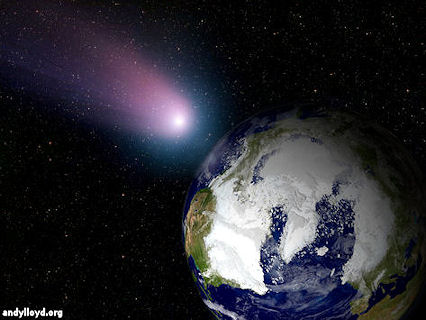
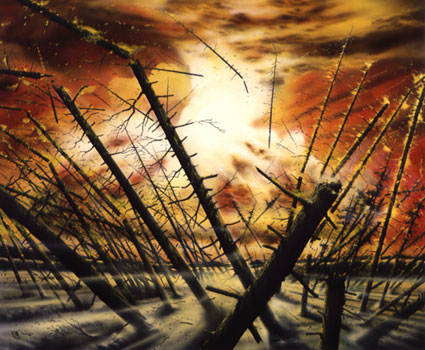
Written by Andy Lloyd,
26th May 2016
References:
1) Graham Hancock "Magicians of the Gods" Coronet 2015
2) Graham Hancock "Fingerprints of the Gods" William Heinemann Ltd 1995
3) Andrew Collins "Göbekli Tepe: Its Cosmic Blueprint Revealed" 2013
4) Vachagan Vahradyan & Marine Vahradyan "About the Astronomical Role of “Qarahunge” Monument"
5) Younger Dryas impact hypothesis
wikipedia.org/wiki/Younger_Dryas_impact
6) R. B. Firestone et al "Evidence for an extraterrestrial impact 12,900 years ago that contributed to the megafaunal extinctions and the Younger Dryas cooling", PNAS, 104:41, 16016–16021, doi: 10.1073/pnas.0706977104, 2007
7) V. Holliday et al "The Younger Dryas impact hypothesis: a cosmic catastrophe", Journal of Quaternary Science, 29:(6), 515–530, 2014
onlinelibrary.wiley.com/doi/10.1002/jqs.2724
8) Zecharia Sitchin "The Twelfth Planet" Avon, 1976, p402, p415
9) J. T. Hollin "Interglacial climates and Antarctic ice surges" Quaternary Research, 1972, 2, 401-408.
10) Walter Sullivan "New Theory on Ice Sheet Catastrophe Is the Direst One Yet" 2 May 1995,
11) Robin Andrews "Colossal Antarctic Ice Shelf Collapsed At End Of Last Ice Age" 22 February 2016
12) Barry Warmkessel "Vulcan and Comets Related Sites"
13) Andy Lloyd "Dark Star Symbolism in the Zohar" 7th March 2016
andylloyd.org/darkstarblog36.htm
14) Konstantin Batygin & Michael Brown "Evidence for a Distant Giant Planet in the Solar System" The Astronomical Journal, 151:2, 20 January 2016,
A Redder, Darker Dwarf Planet
The combined power of two major telescopes has enabled astronomers to re-assess the size and albedo of the dwarf planet 2007 OR10, which moves around the Sun in an elliptical orbit beyond Neptune. This extended scattered disk object, currently located beyond the traditional Kuiper Belt, lies about twice the distance of Pluto away. It turns out to have a remarkably slow rotation, is darker than previously thought, and is significantly larger with a diameter of 955 miles. Its size upgrade makes it the largest un-named body in the solar system; a situation which is unlikely to remain so for much longer:
"According to the new measurements, the diameter of 2007 OR10 is some 155 miles (250 kilometers) larger than previously thought. The larger size also implies higher gravity and a very dark surface -- the latter because the same amount of light is being reflected by a larger body. This dark nature is different from most dwarf planets, which are much brighter. Previous ground-based observations found 2007 OR10 has a characteristic red color, and other researchers have suggested this might be due to methane ices on its surface.
""Our revised larger size for 2007 OR10 makes it increasingly likely the planet is covered in volatile ices of methane, carbon monoxide and nitrogen, which would be easily lost to space by a smaller object," said András Pál at Konkoly Observatory in Budapest, Hungary, who led the research. "It's thrilling to tease out details like this about a distant, new world -- especially since it has such an exceptionally dark and reddish surface for its size."
"As for when 2007 OR10 will finally get a name, that honor belongs to the object's discoverers. Astronomers Meg Schwamb, Mike Brown and David Rabinowitz spotted it in 2007 as part of a survey to search for distant solar system bodies using the Samuel Oschin Telescope at Palomar Observatory near San Diego, California.
""The names of Pluto-sized bodies each tell a story about the characteristics of their respective objects. In the past, we haven't known enough about 2007 OR10 to give it a name that would do it justice," said Schwamb. "I think we're coming to a point where we can give 2007 OR10 its rightful name."" (1)
Just as well they didn't stick with Dr Mike Brown's initial suggestion of 'Snow White'! He seems less than keen to come up with a new name, and next year, ten years on from its initial discovery, the floor will be opened to anyone wishing to make a proposal.
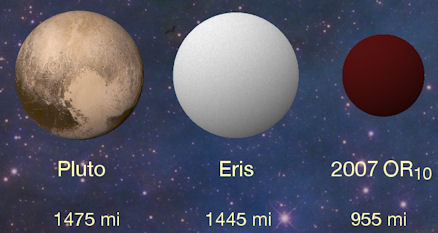
Image Credit: Konkoly Observatory/András Pál, Hungarian Astronomical Association/
Iván Éder, NASA/JHUAPL/SwRI
2007 OR10 turned out to be one of the reddest objects in the Kuiper
Belt, most likely due to methane frosts on the surface when bombarded by
dim sunlight (2). This is somewhat contentious, as we shall see.
The red colour may well be attributable to the presence of organic
substrates on the surface of the dwarf planet, but one wonders why some
Kuiper Belt Objects are strongly coloured in this way, while others show
no evidence of methane frosts at all.
Panspermia theorists N.C. Wickramasinghe and F. Hoyle
advocated the idea that the redness of some of these objects indicate
that they carry complex organic, even biological, materials. They
argued that chemical and biochemical processes are going on below the
surface of these worlds, whereupon biological pigments are being lifted
to the surface. Regarding the evident variety of colourations,
they note that subjecting hydrocarbon mixtures to radiation under
laboratory conditions tends to create neutral, even grey mixtures - not
red - and that the action of sunlight alone on, say, methane, may not be
sufficient to explain the redness seen on some KBOs:
"The fact that the distribution of colour
amongst these objects does not correlate with heliocentric distance
indicates that the intensity of solar radiation does not play an
important role in the colouring process."
Again, one might wonder why such biological processes are taking place on some of these outer solar system objects, but not others. The cold, classical Kuiper Belt Objects are uniformly red, for instance. But many KBOs are white, with relatively high albedos. Why?
Previous work to try to understand the evident distinction between sub-sets of the Kuiper Belt Objects has looked at the way sunlight might affect the organic components contained within different layers of ice. Perhaps the surfaces of these worlds might be 'sand-blasted' by plasma ions in the solar wind (or, indeed larger meteorite material colliding with these objects), exposing lower, redder layers (4). Again, the organic materials within may turn out to be quite complex - including amino acids, the building blocks of life. These arguments rely upon a dynamic equilibrium between the removal of the upper layer of ice, and the generation of complex organic materials thus exposed below. This is, of course, an untested hypothesis.
Another possibility is that this diversity reflects a straightforward difference in composition between these objects, implying different conditions during their initial formation:
"We have two basic ideas about the origin of the color diversity. Firstly, it is possible that the KBOs possess intrinsically different compositions, and that the different colors are tracers of the compositional variation. Is this likely? In the main asteroid belt, asteroids indeed possess different compositions that seem to be related to their sites and temperatures of formation. The KBOs, as far as we know, all formed more or less where we now see them, in the space beyond Neptune. Their formation temperatures would all have been about 40 or 50 K, so it is hard to see how pronounced compositional differences might arise. But they might, and this is a possible interpretation of the data." (5)
Herein lies a most interesting possibility. Could the Kuiper Belt, as well as the extended zone of scattered objects beyond, be composed of a mixture of cosmic bodies of two quite separate origins? This seems a far more straightforward solution, but one which brings with it a new set of challenges for planetary scientists trying to understand the complex anomalies of the outer solar system. Which of the objects are Kuiper belt 'natives', the red or the white? And where did the 'others' come from, exactly?
Written by Andy Lloyd,
14th May 2016
References:
1) Preston Dyches "2007 OR10: Largest Unnamed World in the Solar System" 11 May 2016, with thanks to Lee
2) "(225088) 2007 OR10"
3) N.C. Wickramasinghe and F. Hoyle "The Astonishing Redness of Kuiper-Belt Objects" Astrophysics and Space Science, 268: p 369-372, 1999
4) Space.com Staff "Icy Red Objects at Solar System's Edge May Point to Life's Building Blocks" 29 October 2010
5) Dave Jewitt "Surfaces of Kuiper Belt Objects"
Planet Nine's Mysterious Origins
There has been a multitude of Planet Nine-related academic papers to emerge in the months following the initial announcement of its possible existence back in January (1). Some have tried to narrow down the area of the sky within which it might be located (2), while others have tried to figure out how a major planet could have ended up in such an eccentric orbit, at such a great distance from the other planets in the solar system. This latter question is proving difficult to solve. You might well argue that it's jumping the gun somewhat to try to determine the origins of a world which has yet to be directly observed.
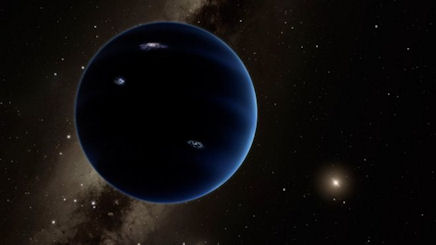
But such is the confidence in the existence of Planet Nine that serious minds are determined to uncover its secrets, prematurely or not. This may have something to do with the long-standing speculation about the planet Nibiru, and the cosmology whirling around it, that was offered by Zecharia Sitchin several decades ago (3). After all, despite what you might hear in the mainstream press when this subject is discussed, the proposed Planet Nine does bear a remarkable resemblance to said fabled world, both in terms of its size, but also several aspects of its likely orbital path (4). This connection, clear to everyone except those at the very centre of this enquiry, needs a resolution just as much as Planet Nine needs to be found. For academics in the astronomical community, that resolution needs to take the form of a resounding negation. So, this urgent requirement is a probable driver for this rather premature investigation into the origin of a world which has yet to actually be discovered. In other words, astronomers need to prove that their Planet Nine is not Nibiru.
If they could show that its origins bear no possible resemblance to Sitchin's proposed cosmology, then this is one path through which they could deny a Nibiru connection. After all, Sitchin's work is very specific on this point - Nibiru was an interloper from outside the solar system which ploughed destructively into the planetary zone, interacted catastrophically with an early form of Earth, and became bound in a highly elliptical, eccentric orbit around the Sun.
The latest Planet Nine-oriented paper, by Gongjie Li of the Harvard-Smithsonian Center for Astrophysics and Fred Adams of the University of Michigan, seeks to determine the probability of various scenarios which could have placed Planet Nine into its current position.
"With such a wide orbit, Planet Nine has a large interaction cross section, and is susceptible to disruption by passing stars. Using a large ensemble of numerical simulations (several million), and Monte Carlo sampling, we calculate the cross sections for different classes of orbit-altering events: [A] scattering the planet into its proposed orbit from a smaller orbit, [B] ejecting it from the Solar System from its current orbit, [C] capturing the planet from another system, and [D] capturing a free-floating planet." (5)
Their findings offer no straightforward solution. Planet Nine really should not be where it is thought to be, orbiting in such a weird orbit. All of the solutions to the mystery are low probability events. This includes scenarios which bear a strong resemblance to Sitchin's speculative proposals about Nibiru:
"Finally, Li and Adams looked at two wilder possibilities: that Planet Nine is an exoplanet that was captured from a passing star system, or a free-floating planet that was captured when it drifted close by our solar system. However, they conclude that the chances of either scenario are less than 2 percent." (6)
This idea of a captured exoplanet has also been examined and advocated by astrophysics researchers, although they too recognise that this is a low probability (but certainly not a zero probability) event (7). What this new work by Li brings forth is the realisation that none of the obvious solutions to this mystery is a likely event. Even if a captured exoplanet scenario is only 2% likely to have occurred, then it is currently competing with other hypotheses which are similarly low probability events. There are no strong front-runners, or firm favourites, in this race. On the contrary, the field, as they say, is wide open.
Written by Andy Lloyd, 9th May 2016
References:
1) Konstantin Batygin & Michael Brown "Evidence for a Distant Giant Planet in the Solar System" The Astronomical Journal, 151:2, 20 January 2016,
2) Andy Lloyd "Haystack Latest: The Hunt for Planet Nine Goes On..." 5-29 April 2016,
andylloyd.org/darkstarblog37.htm
3) Zecharia Sitchin "The Twelfth Planet" Avon, 1976
4) Andy Lloyd "Planet Nine Constellations Predicted by Sitchin, and IRAS" 26 January 2016
andylloyd.org/darkstarblog34.htm
5) Gongjie Li "Interaction Cross Sections and Survival Rates for Proposed Solar System Member Planet Nine", Astrophysical Journal Letters, 823: L3, 26 April 2016,
6) Harvard-Smithsonian Center for Astrophysics Press Release "Planet Nine: A world that shouldn't exist" 3 May 2016, with thanks to Jim
7) Alexander Mustill et al. "Is there an exoplanet in the Solar System?" Monthly Notices of the Royal Astronomical Society: Letters, 460(1): L109–L113, 21 July 2016
Earth-like Planets Orbiting Ultra-Cool Dwarf Star
Three Earth-like worlds have been detected orbiting an ultra-cool dwarf some 40 light years away (1), lying in the constellation Aquarius. The planets are orbiting within the dwarf star's diminished habitable zone, and are likely to be tidally locked at this relative proximity to the dwarf star itself. It's an exciting discovery, because up until this announcement the idea that ultra-cool dwarf stars might harbour habitable planets was only a theoretical possibility - one that has been advocated for many years by researchers such as myself. Now, such systems may arguably be the best place to search for life beyond the Solar System.
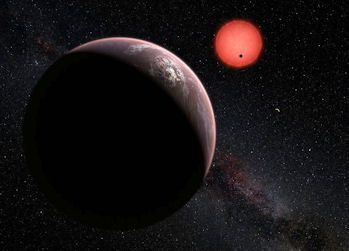
Image credit: ESO/M. Kornmesser/N. Risinger (skysurvey.org)
The TRAPPIST-1 system is the Tom Thumb of the exoplanet systems discovered so far:
""With such short orbital periods, the planets are between 20 and 100 times closer to their star than the Earth to the Sun. The structure of this planetary system is much more similar in scale to the system of Jupiter’s moons than to that of the Solar System," explains Michaël Gillon." (2)
According to Wikipedia, the ultra-cool dwarf star Trappist-1 is about 83 Jupiter masses (although about the same diameter), making it a top-end brown dwarf star (3). Although this is obviously quite a sizeable brown dwarf, it sets an obvious precedent for a tentative Dark Star system closer to home. One of my correspondents, Brian Grant, who first sent me this news by email, made the following insightful comment:
"As Earthlings, it is normal to think that Earth is the rule for creation of life in the universe, because we know there is life here, and so far we have no knowledge of life anywhere else. For the following reasons, I am inclined to think that Earth is likely the exception rather than the rule:
Dwarfs are longer lived than hot stars like earth, so life has longer to develop.
The UV radiation from hot stars like earth make it very challenging for simple life to grow and multiply. That is why UV lamps are used extensively for bacteria and virus control in water and air treatment systems.
Sitchin's account of the collision between the ancient Tiamat and a moon of Nibiru clearly asserts the the transfer of life to Tiamat, now Earth, was one of the consequences of that collision." (4)
I'd agree that dwarf stars do seem to potentially offer the best environments for the long-term evolution of life. As we come to appreciate the chaos of the early solar system, and the catastrophism which has pock-marked its history, one might also argue that the smaller red and brown dwarf systems offer greater protection from outside hazards than substantial yellow dwarfs like the Sun. This, in turn, could enable a smoother evolutionary transition to life, and greater longevity when shielded from the more harmful rays of larger parent stars.
In the case of Nibiru, however, the age of such a Dark Star object (or terrestrial Planet X, whichever you prefer) remains unknown. Although the myths describe its rogue nature and sudden appearance on the solar system scene (probably kicking off the late heavy bombardment some 3.9 billion years ago), that's not to say that it wasn't first an outlying cometary planet orbiting the Sun. Which would make its age similar to the Sun's, as it was likely born in the same stellar nursery cluster.
An alternative possibility is that Nibiru was a
true interstellar interloper. Perhaps it grazed into the solar
system independently, or perhaps it came as an outlying object of a
larger passing star system, and was duly captured by the Sun. A
similar question remains about the origin of Planet Nine (5).
Written by Andy Lloyd, 26th May 2016
References:
1) Michael Gillon et al. "Temperate Earth-sized planets transiting a nearby ultracool dwarf star" Nature, 533, 221-224, 12 May 2016
2) European Southern Observatory Press Release ESO1615 "Three Potentially Habitable Worlds Found Around Nearby Ultracool Dwarf Star" 2 May 2016
3) "TRAPPIST-1"
4) Correspondence from Brian Grant, 16 May 2016
5) Andy Lloyd "Planet Nine's Mysterious Origins" 9 May 2016 (above)
Roma 2016
I've been preparing
two presentations, with Italian slides (!), for the Planet X conference in Rome Sunday 29th May. A risky business with Google translate and my smattering of Italian. I'm really looking forward to meeting up with the many excellent researchers based in Italy, and some now familiar faces in the audience. It'll be a chance to get some feedback on some new ideas I'll be presenting there for the first time - the culmination of an awful lot of work.
The rather wonderful Massimo Fratini, conference organiser and author of 'the Return of Planet X', tells me that the ticket sales have been very good for this event. There seem to be so few opportunities for Sitchin-thinking folk to get together - it's a shame events like this aren't more widespread. I'm very much looking forward to sharing some new ideas about Nibiru with the delegates, complete with a series of new images.
The recent Planet Nine material is obviously going to be a strong talking-point, including the many ways which it ties in with Nibiru, whether astrophysicists like it or not. I'll be sharing ideas as to why this thing, which is now deemed to be 99.999% likely to be real, has proven so tough to detect directly, and how that wraps around the ancient symbolism for this cosmic interloper.
I'll also discuss ancient catastrophism, taking in some of the material in this month's blog.segnidalcieloevent.wix.com/planetxevent

You can keep informed of updates by following me on Twitter:
![]()
Or like my Facebook Page: https://www.facebook.com/darkstarandylloyd